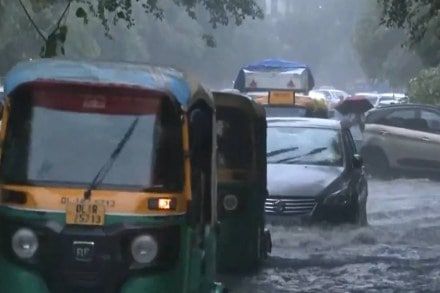By S Abhilash
This monsoon season has lashed several parts of India, particularly in the north, with heavy rainfall, resulting in landslides and floods. These can be attributed to a mix of global climate shifts as well as local factors such as topography and rapid urbanisation, explains S Abhilash
Why rainfall is increasing in Delhi, North India
Dry regions like northwestern India and Delhi are prone to extreme rainfall because they lie at the boundary between tropical and extratropical weather systems. Moist monsoon currents from the Bay of Bengal or Arabian Sea often collide with western disturbances, triggering heavy rainfall across North India. In recent years, this interaction has intensified as mid-latitude westerlies increasingly interact with tropical systems, bringing large amounts of moisture and creating strong atmospheric instability. Climate change is amplifying these processes. Global warming reduces the north-south temperature contrast, which weakens and destabilises the jet stream. This wavering jet stream allows westerly troughs to interact more frequently with monsoon currents, while a warmer atmosphere holds more moisture, strengthening the water cycle and producing more intense downpours. Added to this, rapid urbanisation and the urban heat island effect enhance local convection and runoff, worsening flood impacts.
How are cloudbursts different from extreme rainfall events?
The term cloudburst has been used since the 19th century to describe intense, localised rainfall over a small area (25-30 km2), lasting minutes to a few hours. The meteorological department defines a classical cloudburst as rainfall exceeding 100 mm in one hour. Extreme rainfall events generally cover larger areas and last longer than cloudbursts. All cloudbursts fall in the category of extreme rainfall events; the reverse is not necessarily true. Doppler weather radars (DWRs) and satellites offer coverage but face limitations in mountainous terrain that demands a dense network of automatic weather stations. Cloudbursts are usually linked to orographic forcing (how mountains, hills force an air mass to rise) and deep convection, common in the Himalayas and Western Ghats. They are broadly categorised into “a” (Himalayan events causing severe impact); “b” (>=100 mm in one hour over small areas); and mini cloudbursts (>=50 mm in two hours). These categories remain largely academic.
Himalayas a hotspot for cloudbursts
The Himalayas lie at the intersection of moist tropical monsoon winds and mid-latitude westerlies, creating strong uplift and instability that can trigger cloudbursts. When warm, moisture-laden air is forced up mountain slopes, it cools rapidly, condenses, and produces intense,
localised downpours. Climate change is amplifying this: rapid Arctic warming weakens the jet stream, making westerly troughs interact more frequently with monsoon currents, while warmer air holds more moisture, fuelling heavier rainfall. Together, large-scale atmospheric dynamics, local orography, and global warming are making the Himalayan region increasingly vulnerable to cloudbursts in recent decades. A slower, wavier jet stream causes storms to linger, leading to prolonged heavy rainfall and catastrophic floods, as seen in Germany (2021), Pakistan (2010), and West Asia (2024).
Observational tools & limitations
Current approaches EMPLOY DWRs, satellites, rain gauges, GPS-based moisture monitoring, and high-resolution numerical weather prediction (NWP) models for nowcasting, but significant observational and modelling gaps persist. DWRs offer detailed cloud and rainfall structures but face coverage limitations in the Himalayan terrain. Automatic weather stations and rain gauges offer point-based rainfall measurements yet lack spatial density. Satellite platforms like INSAT-3D/3DR, GPM, and Himawari capture convective growth and precipitation estimates but are constrained by coarse resolution and inherent biases in rugged topography. High-resolution NWP models can simulate convection and storm dynamics but demand fine-scale resolution (<1 km), accurate initial conditions, and explicit process representation, limiting reliability for sudden convective bursts.
Enhanced dense observation networks, connection-permitting models with better representation of cloudburst processes, and the integration of AI/ML learning techniques for data assimilation are essential for improving forecasts.
Challenges in urban regions
Flash floods are an increasing threat in Indian cities, intensified by rapid urbanisation and climate change. Assessing pluvial flood risk is challenging due the unpredictability of locations, leaving large urban areas and infrastructure vulnerable. Poorly regulated development in unstable slopes further amplifies risks, highlighting the need for strict enforcement of building codes. Most urban drainage systems are built for only 10-20 mm/hr rainfall, while cloudbursts can exceed 100 mm/hr, making urgent redesign essential. Effective stormwater management requires integrated strategies combining rainfall analysis, engineering, policy, and community participation. Key measures include reducing runoff volumes by converting impervious surfaces into pervious ones and enhancing stormwater systems to cope with extreme rainfall events.
The writer is director, Advanced Centre for Atmospheric Radar Research, Cochin University of Science and Technology, Kochi.
Disclaimer: Views expressed are personal and do not reflect the official position or policy of FinancialExpress.com. Reproducing this content without permission is prohibited.
